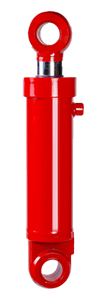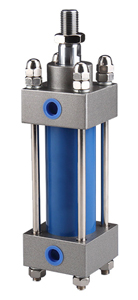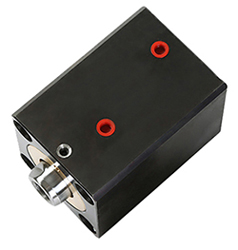What are the Types of Hydraulic Cylinders?
A hydraulic cylinder is a mechanical device that achieves linear motion by pushing a fluid (usually hydraulic oil) through a closed container. This device usually consists of a cylinder, a piston and a rod connected to it. The working principle of a hydraulic cylinder is based on a pipeline system with hydraulic oil, which exerts force on the pressure of the liquid to move the piston inside the cylinder.
When fluid is pumped into the cylinder, it exerts pressure on the piston, creating a push force that causes the piston to move along the axis of the barrel. Hydraulic cylinders are widely used in industrial and mechanical applications such as lifting machinery, punch presses, excavators, injection molding machines, etc. Due to their high load-bearing capacity, precise position control and reliability, hydraulic cylinders are important actuators in many fields.
Types of Hydraulic Cylinders
Welded Hydraulic Cylinder
 Welded hydraulic cylinder is a kind of hydraulic actuator, which is usually used in engineering machinery, agricultural machinery, construction machinery and other equipment. Its main function is to convert mechanical energy into linear motion through hydraulic force, thereby driving related mechanical components. The characteristic of the welding hydraulic cylinder is that its structure uses welded connections instead of bolted connections.
Welded hydraulic cylinder is a kind of hydraulic actuator, which is usually used in engineering machinery, agricultural machinery, construction machinery and other equipment. Its main function is to convert mechanical energy into linear motion through hydraulic force, thereby driving related mechanical components. The characteristic of the welding hydraulic cylinder is that its structure uses welded connections instead of bolted connections.
The main components of welding hydraulic cylinders include:
- Cylinder Barrel: It is the main structure of the hydraulic cylinder, usually made of welded steel pipes. The cylinder cavity houses the piston and sealing elements.
- Piston: It is a moving part in a hydraulic cylinder. It is usually a cylindrical metal part that fits tightly in the cylinder and is pushed by hydraulic force.
- Sealing Components: Components used to prevent liquid leakage in hydraulic cylinders, including piston seals, cylinder head seals, etc.
- Cylinder Head: Closes one end of the hydraulic cylinder. It is usually connected to the cylinder body through welding to protect and seal.
- Piston Rod: Connects the piston and external mechanical parts, and is responsible for transmitting the movement of the piston to the outside.
- Connector: The element that connects a hydraulic cylinder to other mechanical components. These connections may be welded or bolted, depending on the design and application requirements.
Welded hydraulic cylinders are usually used in situations where structural strength and compactness are required. Welded connections provide a stronger structure and are suitable for situations where greater operating pressures and loads are to be tolerated. This type of hydraulic cylinder is widely used in various industrial and agricultural fields, providing effective power transmission and control.
Tie Rod Hydraulic Cylinder
 The tie rod hydraulic cylinder is a hydraulic actuator that is usually used to convert liquid energy into mechanical motion. It consists of an outer metal cylinder and an inner piston rod. Fluid (usually hydraulic oil) enters through a port in the barrel and exerts pressure on the piston, forcing the piston rod to perform linear motion. The design of the tie rod hydraulic cylinder allows the piston rod to extend out on one side of the barrel, which is why it is called a tie rod cylinder. This type of hydraulic cylinder is commonly found in industrial and mechanical applications where it is used to perform a variety of tasks such as pushing, pulling, lifting or compressing. In mechanical systems, tie rod hydraulic cylinders are often used in applications that require high output, as they are capable of delivering considerable push and pull forces.
The tie rod hydraulic cylinder is a hydraulic actuator that is usually used to convert liquid energy into mechanical motion. It consists of an outer metal cylinder and an inner piston rod. Fluid (usually hydraulic oil) enters through a port in the barrel and exerts pressure on the piston, forcing the piston rod to perform linear motion. The design of the tie rod hydraulic cylinder allows the piston rod to extend out on one side of the barrel, which is why it is called a tie rod cylinder. This type of hydraulic cylinder is commonly found in industrial and mechanical applications where it is used to perform a variety of tasks such as pushing, pulling, lifting or compressing. In mechanical systems, tie rod hydraulic cylinders are often used in applications that require high output, as they are capable of delivering considerable push and pull forces.
The working principle of the tie rod hydraulic cylinder is based on a closed system with liquid. The following are the general working steps of it:
- Fluid Supply: Fluid (usually hydraulic oil) is pumped from the reservoir of the hydraulic system to the oil inlet of the hydraulic cylinder.
- Liquid Enters the Cylinder: The liquid enters the cylinder part of the hydraulic cylinder through the oil inlet.
- Piston Movement: The entry of liquid causes the piston to be pushed, causing the piston rod to extend. This results in the movement of the tie rod hydraulic cylinder.
- Work Execution: The extension or retraction of the piston rod pushes the connected mechanical system to perform specific work tasks, such as pushing machine parts, lifting goods, etc.
- Liquid Discharge: After the piston movement is completed, the liquid flows back to the oil tank through the oil outlet of the hydraulic cylinder, ready for the next cycle.
The ability and performance of a tie rod hydraulic cylinder are often affected by design, fluid pressure, and material quality. These hydraulic cylinders can have different sizes, push and pull forces, speeds, and other characteristics depending on the application needs. In industrial and mechanical engineering, tie rod hydraulic cylinders are widely used in various automation and control systems to provide efficient and reliable power output.
Compact Hydraulic Cylinder

A compact hydraulic cylinder is a device used to produce linear motion. It usually consists of a piston and a piston rod connected to it. Hydraulic force is transmitted to the piston to produce linear motion. Its compact design means it takes up less space, making it suitable for applications with limited installation space. This compact hydraulic cylinder is typically used in systems that require high force density but limited space, such as mechanical equipment, industrial machinery, automation systems, and mobile equipment. This hydraulic cylinder is designed to provide powerful push and pull forces in confined spaces while remaining compact and lightweight. It plays an important role in many industrial applications, providing efficient hydraulic power transmission and control.
Compact hydraulic cylinders have the following specific design features to meet the requirements of compact space and efficient performance.
- Short Stroke: Compact hydraulic cylinders are typically designed for relatively short strokes to fit into limited installation space.
- Lightweight Design: To provide high force density in a limited space, these cylinders are often designed with lightweight materials and structures to reduce overall weight.
- High Performance: These cylinders are typically designed to be high-performance to ensure maximum mechanical output for a given input of hydraulic energy.
- Sealing Performance: Since hydraulic cylinders are usually used in harsh working environments, their sealing performance is very critical to prevent liquid leakage and ensure system reliability.
- Integrated Design: To minimize external dimensions, Compact Hydraulic Cylinders may integrate valves, sensors, or other control elements, making them integrated hydraulic actuators.
- Versatility: These cylinders may be designed to serve multiple functions, such as damping, regulating speed, or providing positioning control, to meet the needs of different applications.
Telescopic Hydraulic Cylinder
A telescopic hydraulic cylinder, also known as a multi-stage hydraulic cylinder or telescopic cylinder, is a hydraulic actuator that provides linear force and movement through hydraulic fluid pressure. The tanks contain multiple nested levels, one inside the other, that can be expanded and contracted. The main advantage of telescopic hydraulic cylinders is their ability to achieve long strokes while maintaining a relatively small retraction length. This makes them suitable for applications where space is limited and long stretches are required. Common applications include dump trucks, cranes, forklifts, and various types of material handling equipment.
Each level of the telescopic hydraulic cylinder is connected by hydraulic lines. When hydraulic fluid is pumped into the cylinder, it causes the stages to stretch, providing the required linear motion. Instead, the stages shrink when fluid is released or pumped in the opposite direction. Telescopic hydraulic cylinders offer versatility and different levels of cylinders can be designed according to the specific requirements of the application. They are widely used in a variety of industries to lift, push, and pull heavy loads in a controlled and efficient manner.

